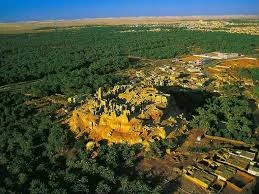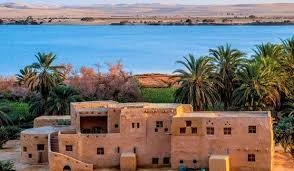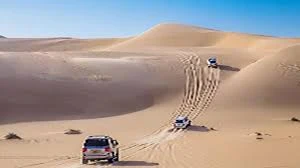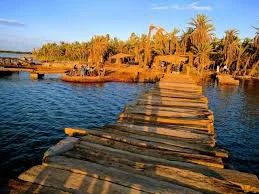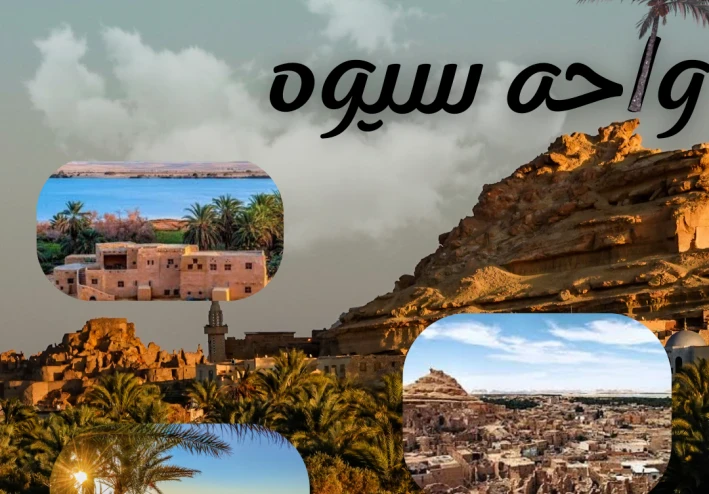
"Siwa Oasis: The Jewel of the Western Desert and Its Unique Tourist and Archaeological Landmarks
Introduction
Siwa Oasis is one of the most beautiful and rare tourist destinations in Egypt and even in the entire world. It is located in the far west of Egypt, near the Libyan border, and resembles a sparkling gem in the heart of the Western Desert. Siwa has been renowned for thousands of years for its historical and religious significance. It is also one of the few places that has preserved much of its cultural and linguistic identity, as its people still speak their own language known as Siwi or Amazigh, alongside Arabic. The uniqueness of Siwa lies in its relative isolation from the rest of Egypt, which helped it retain its traditions and customs to a great extent.
Safari trips in Siwa Oasis are among the most attractive activities for tourists from all over the world. They are not just desert tours but exceptional experiences that combine adventure, excitement, and discovery. The desert surrounding Siwa stretches across vast areas of sand dunes, lakes, and small oases, making it an ideal destination for desert adventurers and lovers of unspoiled nature.
The adventure usually begins with four-wheel-drive vehicles led by local guides who are well-versed in the desert and its paths. Visitors embark on thrilling journeys across high and low dunes, experiencing the excitement of fast sand driving, one of the most exhilarating moments of the trip. This activity offers breathtaking panoramic views of the wide desert, especially at sunset, when the sands turn into dazzling golden and orange hues.
In addition to dune adventures, safari trips often include stops at unique natural sites such as Siwa’s famous salt lakes, where visitors can enjoy swimming in crystal-clear waters believed to have therapeutic properties. Other stops may include hot spring wells that are said to provide health benefits, offering relaxation amid rare natural surroundings. No safari trip is complete without camping in the heart of the desert, where tourists gather around campfires under a star-studded sky, enjoying Bedouin hospitality, music, and stories—a truly unforgettable experience.
Tourist and Archaeological Landmarks
Siwa Oasis is rich in historical and tourist landmarks that make it a unique destination for lovers of history and culture. Among the most prominent sites are:
The Temple of Amun (Oracle Temple): One of the most famous historical sites in Siwa, closely associated with Alexander the Great, who visited the temple in 331 BC to consult the priests of Amun. Although only ruins remain today on Aghurmi Hill, the temple still holds immense historical significance.
The Mountain of the Dead: A necropolis carved into rock, dating back to the Pharaonic, Ptolemaic, and Roman eras. The tombs are adorned with colorful decorations and inscriptions. Notable tombs include the Tomb of Si-Amun, the Tomb of Mesu-Isis, and the Tomb of the Crocodile, all of which reflect the diverse civilizations that once inhabited Siwa.
Shali Fortress: Built in the 13th century AD from kershef (a mixture of salt and clay), it once served as a defensive stronghold for the Siwan people. Although partially eroded by rain, its ruins still stand as a striking example of environmental architecture and local ingenuity.
The Temple of Umm Ubayda: Constructed during the reign of King Nectanebo II of the 30th Dynasty. Although most of it has collapsed, its remaining inscriptions point to its religious significance in ancient times.
Cleopatra’s Spring: A natural circular spring where, according to legend, Queen Cleopatra herself once bathed. Today, it is a popular site for visitors seeking a refreshing swim in its bubbling waters. Nearby, other springs such as Fatnas Spring and Kigar Spring offer equally relaxing experiences amid beautiful natural settings.
The Mountain of Dakrur: Famous for its annual Festival of Tourism and Tolerance, this mountain is also known for its therapeutic hot sand baths, used as a natural remedy for rheumatism and joint pain.
Salt Lakes: Siwa is home to several salt lakes such as Lake Zeitoun and Fatnas Lake, which not only serve therapeutic purposes but also provide breathtaking views at sunset. Surrounded by golden sands and a clear sky, these lakes make Siwa resemble a hidden paradise in the heart of the desert.
In addition to its landmarks, Siwa is also renowned for producing some of the finest dates and olives in Egypt and beyond. Its unique architecture, built from salt and clay, gives the oasis a distinctive character, while its traditions and customs reflect simplicity, generosity, and authenticity.
Siwa Oasis is, in every sense, a rare blend of ancient history, stunning natural beauty, and a unique cultural heritage. It is not merely an oasis in the desert, but an open-air museum showcasing civilizations of the past, while offering peace, inspiration, and a deeply spiritual atmosphere to all who visit.





